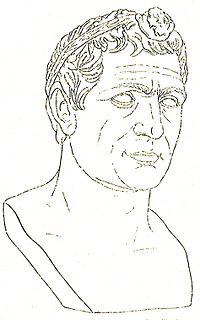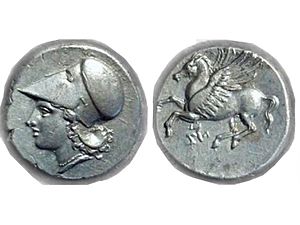Agathocles of Syracuse facts for kids
Quick facts for kids Agathocles |
|
|---|---|
| King of Syracuse | |

Depiction of a bust possibly belonging to Agathocles
|
|
| Reign | 317 - 289 BC |
| Predecessor | Timoleon |
| Successor | Hicetas |
| Born | 361 BC Himera |
| Died | 289 BC Syracuse |
| Consort | Theoxena |
| Issue | With first wife
With Alcia?
With Theoxena
|
| Greek | Ἀγαθοκλῆς |
| Father | Carcinus of Rhegium |
| Religion | Greek Polytheism |
Agathocles (Greek: Ἀγαθοκλῆς, Agathoklḗs; 361–289 BC) was a powerful Greek leader. He was a tyrant (a ruler who took power by force) of Syracuse from 317 to 289 BC. Later, he even called himself king of Sicily from 304 to 289 BC.
Contents
Who was Agathocles?
Agathocles was born in a place called Thermae Himeraeae in Sicily. His father was a potter who later moved to Syracuse. Agathocles learned his father's trade, but he soon joined the army. His brother, Antander, also joined the army with him.
In 333 BC, Agathocles married a wealthy woman. She was the widow of his mentor, Damas. Agathocles was sent away from Syracuse twice. This happened because he tried to take power from the ruling group, called the oligarchy. An oligarchy is when a small group of powerful people rule.
Agathocles takes control
In 317 BC, Agathocles returned to Syracuse. He had an army of mercenaries (soldiers who fight for money). He promised to respect the democracy (rule by the people) that was in place. But after his army took the city, he removed the oligarchs and the richest citizens. This made him the master of Syracuse.
He then built a strong army and navy. With these forces, he took control of most of Sicily.
Wars with Carthage
Agathocles soon faced a big war with Carthage. Carthage was a powerful city in North Africa. In 311 BC, Agathocles lost a major battle at the Himera River. His city, Syracuse, was then surrounded and attacked. This is called a siege.
In 310 BC, Agathocles made a bold move. He broke through the Carthaginian blockade (when enemies surround a place to stop supplies). He sailed his army to North Africa to attack Carthage directly. He landed at Cape Bon in August 310 BC. There, he defeated the Carthaginians for the first time. He set up a camp near Tunis.
He then tried to take over coastal trading cities. These included Neapolis and Hadrumetum. He even made an alliance with Aelymas, the king of the Libyans. This was an attempt to surround Carthage. After capturing Hadrumetum and other towns, Agathocles focused on central Tunisia.
A risky alliance
Around this time, Agathocles broke his alliance with Aelymas. He pursued and killed Aelymas. But he kept Aelymas's army, including their war chariots.
In 309/8 BC, Agathocles tried to get Ophellas to join him. Ophellas was the ruler of Cyrenaica. Agathocles thought Ophellas would be a good ally against Carthage. He promised Ophellas any lands they conquered in Africa. Agathocles would only keep Sicily for himself.
Ophellas gathered a large army from Athens. Many citizens there were unhappy with their government. Ophellas's journey to Carthaginian lands was long and difficult. It took more than two months. Agathocles welcomed Ophellas warmly. The two armies camped near each other. But a few days later, Agathocles betrayed Ophellas. He attacked the Cyrenean camp and had Ophellas killed. The Cyrenean soldiers, without their leader, then joined Agathocles.
King of Sicily
After more battles, Agathocles was finally defeated in 307 BC. He secretly fled back to Sicily. In 306 BC, he made peace with Carthage. This treaty left him in control of eastern Sicily.
In 304 BC, Agathocles declared himself king of Sicily. He made his rule over the Greek cities on the island stronger than ever. Even when he was old, he was full of energy. It is said he was planning another attack on Carthage when he died.
His final years
Agathocles' last years were difficult. He suffered from poor health. His grandson, Archagathus, caused him trouble. Some say his grandson had him poisoned. Others believe he died a natural death.
Agathocles was a natural leader of soldiers. He used harsh methods to achieve his goals. But once he was in power, he was a fair and popular ruler. Before he died, Agathocles restored democracy in Syracuse. He did not want his sons to become king after him.
Agathocles was married three times. His first wife was the widow of his mentor, Damas. They had two sons, Archagathus and his brother. Both were killed in 307 BC. His second wife was Alcia. They had a daughter, Lanassa, and a son, Agathocles. This son was killed in a power struggle before his father died.
His third wife was Theoxena, a Greek princess from Egypt. Theoxena was the stepdaughter of Ptolemy I Soter, the king of Egypt. Agathocles and Theoxena had two children: Archagathus and Theoxena. Theoxena outlived Agathocles. He had more descendants from his second and third marriages.
What was Agathocles' legacy?
Agathocles is mentioned in a famous book called The Prince. This book was written by Niccolò Machiavelli in 1513. Machiavelli used Agathocles as an example of a leader who gained power through strong actions.
Machiavelli described Agathocles as a very determined person. He said that Agathocles, who was the son of a potter, rose to become a powerful leader. He did this by being very skilled and strong-willed.
Machiavelli also noted that Agathocles' success came from acting quickly and firmly. He believed that a leader's tough actions should be used only when needed for safety. These actions should also benefit the people. Agathocles became famous not just for his strong rule. He also gained loyalty from his people by fighting off the Carthaginians.
Family tree of Agathocles
| Magas | Antigone of Macedon | ||||||||||||||||||||||||||||||||||||||||||||||||||||||||||||||||||||
| Carcinus of Regium | Philip | Berenice I | Ptolemy I king of Egypt |
||||||||||||||||||||||||||||||||||||||||||||||||||||||||||||||||||
| 1.(unknown) | Agathocles I tyrant of Syracuse, king of Sicily |
3.Theoxena Elder | Ptolemy II king of Egypt |
||||||||||||||||||||||||||||||||||||||||||||||||||||||||||||||||||
| 2.Alcia | |||||||||||||||||||||||||||||||||||||||||||||||||||||||||||||||||||||
| Archagathus Elder general ∞ Theoxena |
Heracleides military officer |
Agathocles II | Lanassa | Pyrrhus I king of Epirus |
Antigone | Archagathus of Libya epistates of Cyrenaica ∞ Oenanthe |
Theoxena Younger | Ptolemy III king of Egypt |
|||||||||||||||||||||||||||||||||||||||||||||||||||||||||||||
| Archagathus Younger military officer |
Agathocles Elder ∞ Oenanthe |
Ptolemy IV king of Egypt |
|||||||||||||||||||||||||||||||||||||||||||||||||||||||||||||||||||
| Agathoclea | Agathocles Younger | Ptolemy V king of Egypt |
|||||||||||||||||||||||||||||||||||||||||||||||||||||||||||||||||||
Primary sources
- Diodorus Siculus Library of History Books 19–21.
- Justin, Epitome of Pompeius Trogus Book 22.
- Polyaenus 5.3
- Polybius 9.23
See also
 In Spanish: Agatocles para niños
In Spanish: Agatocles para niños


